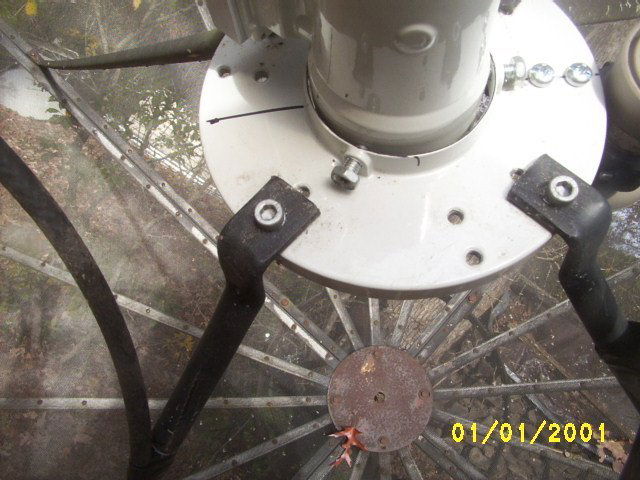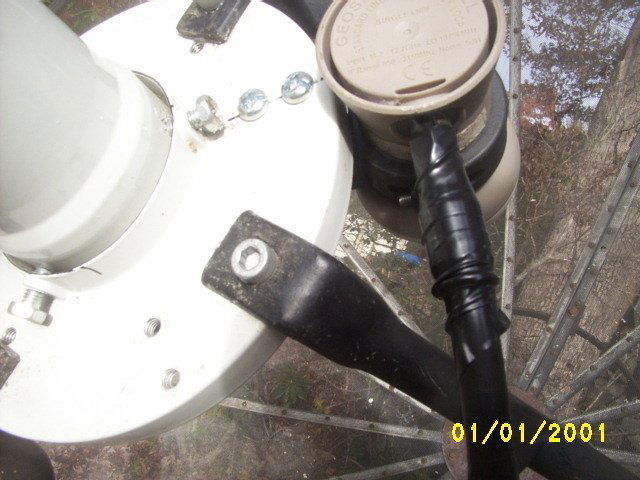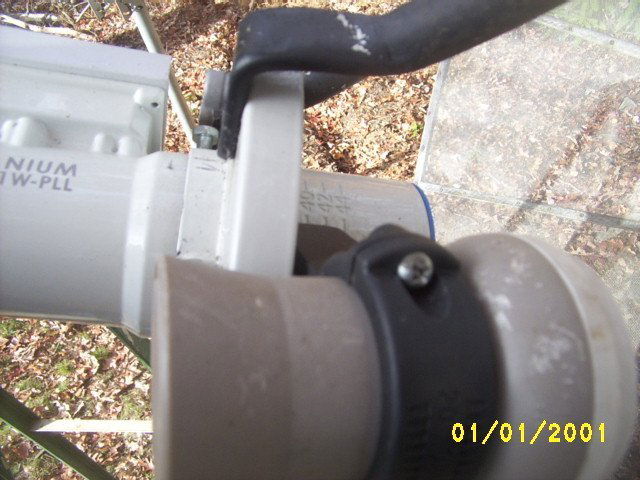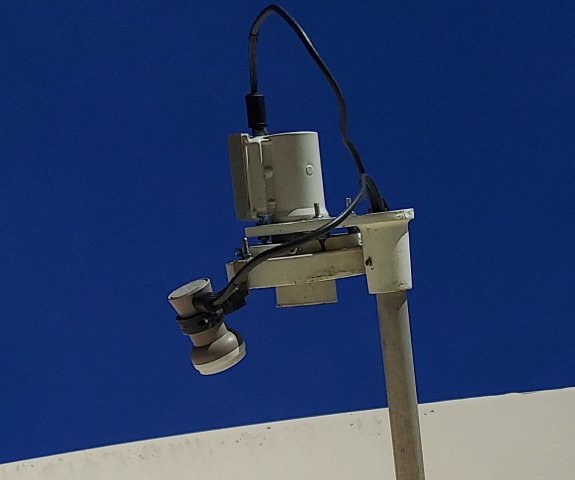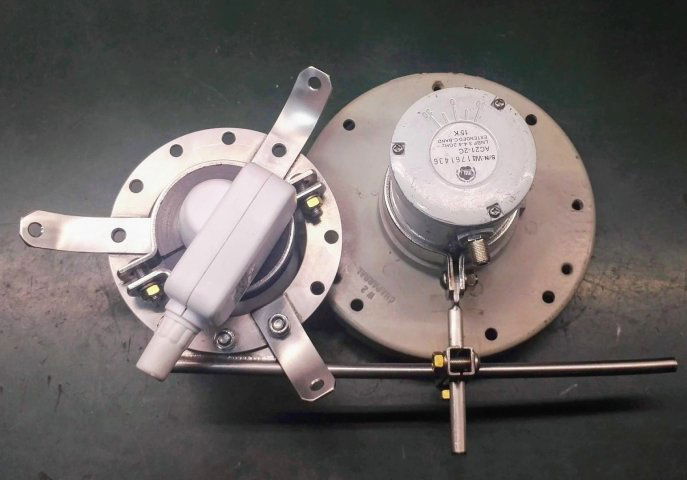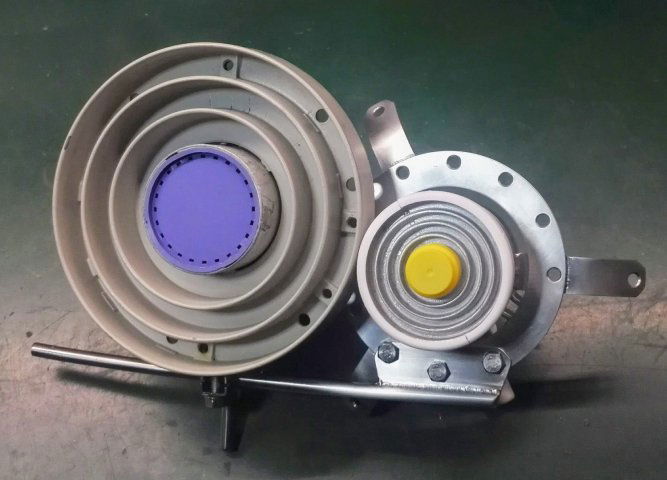I want to add Ku Band to my Cband Dish.
- Thread starter Conway
- Start date
- Latest activity Latest activity:
- Replies 37
- Views 4K
You are using an out of date browser. It may not display this or other websites correctly.
You should upgrade or use an alternative browser.
You should upgrade or use an alternative browser.
You can do it a few different ways depending on how much money you want to spend, this is the cheapest way using Chaparral Corotor II Plus c/ku-band FeedhornI want to add Ku band to my 10Ft Cband Mesh Dish.. Where can I buy the Scaler I need to add a Ku band LNB to my set up? Thank You
But if you don't want to use a servo motor ... you need to use a bullsyes feed horn for C and KU.....
I know this wasn't your question but If you have the room and the budget, install a separate Ku dish. My old 36 inch Starchoice dish with a GEOSAT pro performs better than my 10 foot mesh with a Cal-Amp C-Ku feed horn. You will also find it difficult to get your 10 foot to land on the Ku satellites accurately.I want to add Ku band to my 10Ft Cband Mesh Dish.. Where can I buy the Scaler I need to add a Ku band LNB to my set up? Thank You
You do that... and you can NEVER have it center correctly that is a cheap way but it will be off center when you turn your dishcheapest way it sidecar your ku lnb....iget the same strenth as i did on my 48 inch ku dish. 3 pictures attached
I've had the same setup with a geosatpro lnbf for several years.Cheap and easy and pretty darned good signal strength. It still illuminates only a portion of the 12 footer....because it's designed for a smaller dish.
And yeah. Playing around finding the sweet spot because I have a buttonhook feed ends up with the lnbf reflecting East around 5-6 degrees difference for the same sat. on C band. No biggie.
Never a concern with C band reception on an E2 receiver. The "Filter out adjacent satellites" up to X degrees during a blindscan with "Disable sync with known satellites" set to No becomes handy due to signal bleed over.
Dunno if it's an issue with the same setup on smaller dishes. But it sure can have you scratching your head when you come up with far more transponders than listed in charts. And some have a lot less signal. Right?
It works, it's cheap. I held mine in my hand when aiming for a signal then made the bracket to attach it to the scalar.
Of late though in the low SR challenge post here. Could be the footprint. Could be other things. Tweaks?
Having a time snagging signal at all on them. But hey. What's worth really watching on ku?
So there you have it.
And yeah. Playing around finding the sweet spot because I have a buttonhook feed ends up with the lnbf reflecting East around 5-6 degrees difference for the same sat. on C band. No biggie.
Never a concern with C band reception on an E2 receiver. The "Filter out adjacent satellites" up to X degrees during a blindscan with "Disable sync with known satellites" set to No becomes handy due to signal bleed over.
Dunno if it's an issue with the same setup on smaller dishes. But it sure can have you scratching your head when you come up with far more transponders than listed in charts. And some have a lot less signal. Right?
It works, it's cheap. I held mine in my hand when aiming for a signal then made the bracket to attach it to the scalar.
Of late though in the low SR challenge post here. Could be the footprint. Could be other things. Tweaks?
Having a time snagging signal at all on them. But hey. What's worth really watching on ku?
So there you have it.
Attachments
Is that a Titanium LNBF with a Chaparral scaler ring?I've had the same setup with a geosatpro lnbf for several years.Cheap and easy and pretty darned good signal strength. It still illuminates only a portion of the 12 footer....because it's designed for a smaller dish.
And yeah. Playing around finding the sweet spot because I have a buttonhook feed ends up with the lnbf reflecting East around 5-6 degrees difference for the same sat. on C band. No biggie.
Never a concern with C band reception on an E2 receiver. The "Filter out adjacent satellites" up to X degrees during a blindscan with "Disable sync with known satellites" set to No becomes handy due to signal bleed over.
Dunno if it's an issue with the same setup on smaller dishes. But it sure can have you scratching your head when you come up with far more transponders than listed in charts. And some have a lot less signal. Right?
It works, it's cheap. I held mine in my hand when aiming for a signal then made the bracket to attach it to the scalar.
Of late though in the low SR challenge post here. Could be the footprint. Could be other things. Tweaks?
Having a time snagging signal at all on them. But hey. What's worth really watching on ku?
So there you have it.
my 4 foot motor went out a year ago and that is when i moved it to my 10 foot dish and got the exact same ku channels with strength i had before as I keep a list that i update monthly on strength......it can be done but takes a little bit of work
For interest's sake... and because I do not believe I have seen it mentioned in anywhere in the forums, even after extensive searching...
Has anyone installed a prime focus Ku LNBF with a flat scalar as a side car? How did it perform versus the integrated conical scalar in an offset LNBF?
The conical scalar Ku LNBF - on paper - should suffer from reduced illumination + a substantial reduction in gain due to the offset on the radiation pattern envelope. When I compare to the RPE for a terrestrial microwave antenna operating in a similar but adjacent band, I would expect the ~ 9 to 10 dB of additional inherent gain in Ku to be eliminated AND THEN SOME. Based on some rough calcs, a 3 m reflector with roughly 40 dB of C band gain should have about 49 dB of Ku gain. This is corroborated by vendor spec sheets for both satellite and terrestrial reflectors, plus figures from online calculators. Factor in at least 10 dB of RPE reduction due to being off-axis and that the 3 m should perform no better than a dedicated 1.2 m Ku. This doesn't even factor in the focal length disparity or the effects of the stepped conical scalar or the effect of the Ku -3 dB beam width being much narrower than that of C band.
Based on these figures, I have to wonder about the true, practical downside effect of using a LNBF designed for offset reflectors as a prime focus side car. On paper, the off-axis RPE should have at least the same or greater effect on received signal levels than does the f/D under-illumination or the conical scalar.
Has anyone tried cutting the feedhorn off a Ku LNBF and operating as a side car without any form of scalar?
Has anyone installed a prime focus Ku LNBF with a flat scalar as a side car? How did it perform versus the integrated conical scalar in an offset LNBF?
The conical scalar Ku LNBF - on paper - should suffer from reduced illumination + a substantial reduction in gain due to the offset on the radiation pattern envelope. When I compare to the RPE for a terrestrial microwave antenna operating in a similar but adjacent band, I would expect the ~ 9 to 10 dB of additional inherent gain in Ku to be eliminated AND THEN SOME. Based on some rough calcs, a 3 m reflector with roughly 40 dB of C band gain should have about 49 dB of Ku gain. This is corroborated by vendor spec sheets for both satellite and terrestrial reflectors, plus figures from online calculators. Factor in at least 10 dB of RPE reduction due to being off-axis and that the 3 m should perform no better than a dedicated 1.2 m Ku. This doesn't even factor in the focal length disparity or the effects of the stepped conical scalar or the effect of the Ku -3 dB beam width being much narrower than that of C band.
Based on these figures, I have to wonder about the true, practical downside effect of using a LNBF designed for offset reflectors as a prime focus side car. On paper, the off-axis RPE should have at least the same or greater effect on received signal levels than does the f/D under-illumination or the conical scalar.
Has anyone tried cutting the feedhorn off a Ku LNBF and operating as a side car without any form of scalar?
It was at the time I took the pic. Now have a ortho setup for c band. The slight misalignments you might see are just from setting it all up back then.Is that a Titanium LNBF with a Chaparral scaler ring?
With all of the theoretical jargon aside. Relating to scanner dudes mentioning that 75 ohm coax don't make a difference. Within limits my choice is to do it right. You know?For interest's sake... and because I do not believe I have seen it mentioned in anywhere in the forums, even after extensive searching...
Has anyone installed a prime focus Ku LNBF with a flat scalar as a side car? How did it perform versus the integrated conical scalar in an offset LNBF?
The conical scalar Ku LNBF - on paper - should suffer from reduced illumination + a substantial reduction in gain due to the offset on the radiation pattern envelope. When I compare to the RPE for a terrestrial microwave antenna operating in a similar but adjacent band, I would expect the ~ 9 to 10 dB of additional inherent gain in Ku to be eliminated AND THEN SOME. Based on some rough calcs, a 3 m reflector with roughly 40 dB of C band gain should have about 49 dB of Ku gain. This is corroborated by vendor spec sheets for both satellite and terrestrial reflectors, plus figures from online calculators. Factor in at least 10 dB of RPE reduction due to being off-axis and that the 3 m should perform no better than a dedicated 1.2 m Ku. This doesn't even factor in the focal length disparity or the effects of the stepped conical scalar or the effect of the Ku -3 dB beam width being much narrower than that of C band.
Based on these figures, I have to wonder about the true, practical downside effect of using a LNBF designed for offset reflectors as a prime focus side car. On paper, the off-axis RPE should have at least the same or greater effect on received signal levels than does the f/D under-illumination or the conical scalar.
Has anyone tried cutting the feedhorn off a Ku LNBF and operating as a side car without any form of scalar?
There are the "figure eight" looking dual scalars for multiple feeds both C band and C/Ku mounting.
And from web searches there are Aussies and Kiwis that don't even use scalar rings.
I have not tried it. But playing with scalar distance from dish center versus the hard and set f and f/D calcs. does end up with finding a sweet spot. And have never been exactly what the abacus and slide rule derived.
Thing is. And info (for me) is all over the place. How big of an offset dish could be used with a conical scalar? And although it makes some sense. Conical scalars are just cone-shaped. Nothing is designed in them to conform to the geometry of an offset dish. So why wouldn't a flat scalar work as good. Not fishing for answers really. But still..
I did read somewhere that trimming off a few mm or so from the front of a ku lnbf like the geosat I have made for an offset dish (no scalar...it's in the casting under the plastic cover). Fixed to a prime feed dish. Would increase signal a bit by allowing them to illuminate more of a larger dish. Because it's cheap. Easily swapped out if I screwed up.
I belt sanded some off. Slapped it back on the dish. Not much if any signal gain. Took a little more off. Still the same.
And what IS the deal with the fig. eight scalars if one is so important? A partial circle is missing from both. To get the lnb's closer to each other versus two individual correct scalars? It's a hobby. Sometimes theory is tossed out the door and just-try-it-and-see prevails.
Guys I appreciate the pictures! I was having a hard time wrapping my head around how to add a cheap KU band LNB to my dish. I have one of those brackets todo it the cheap way.. hehe. I do have old Directv slimline and Hughesnet dishes and Dishnetwork dishes laying around here. When it cools off I will tinker with adding it. I could easily do a stationary set up but I wanted to have it on my Cband dish because it's movable. Who knows I might do it both ways 
... should suffer from reduced illumination + a substantial reduction in gain due to the offset
Reduced illumination: agreed.
Illumination angle of a normal Ku LNBf for an offset dish would be about 75 degrees (based on e.g. the Triax 115 dish), I guess, so equivalent to an f/D of about 0.75.
Compare it to the f/D of the PF dish, and you can calculate what diameter of the dish is "seen" by the LNB.
Substantially reduced gain due to the LNB being placed off-axis? I don't know how substantial this would be?
For multifeed setups on e.g. a Triax 78 dish, the loss of an 10 degree off-axis-mounted LNB would only be 1 dB, according to this graph:
Not very substantial, I would say.
And what do you mean with what you write about focal length disparity? Would the focal length change? That is new to me.
I don't know much about feedhorns and (conical) scalars and the like, though, so I leave that subject to others.
Greetz,
A33
I agree I found using KU and C-band on the same dish so-so and you better get the KU dead on don't even think about the C-band part I have done a 14 foot C and Ku what a bitch that job wasI know this wasn't your question but If you have the room and the budget, install a separate Ku dish. My old 36 inch Starchoice dish with a GEOSAT pro performs better than my 10 foot mesh with a Cal-Amp C-Ku feed horn. You will also find it difficult to get your 10 foot to land on the Ku satellites accurately.
Some mixed feeling here I see. Let's play a little game. A little while ago today I tweaked the bracket for the Geosatpro lnbf on my now c band ortho feed. Pretty much the same as in the photo above. I'm on the East coast in N. PA. Best possible signal attained..
Shoot me some ku sats and channels on them and lets compare signals.
F'rinstance. Right now on 99W. Edision osmio4k. OpenViX 6.7.013. Transplanted tnap mod tuner driver.
99W ku:
FNX 11.2 dB
Montana PBS 9.6 dB. Picture is locked solid and stable. No pixelation.
NBC East HD 11 db.
117W ku:
Reflections 11.5 dB
KBS Americas 11.3 dB
Aprende TV 11731V 8.0 dB Solid picture.
Give me some difficult sat/tp's in an East coast footprint.
Shoot me some ku sats and channels on them and lets compare signals.
F'rinstance. Right now on 99W. Edision osmio4k. OpenViX 6.7.013. Transplanted tnap mod tuner driver.
99W ku:
FNX 11.2 dB
Montana PBS 9.6 dB. Picture is locked solid and stable. No pixelation.
NBC East HD 11 db.
117W ku:
Reflections 11.5 dB
KBS Americas 11.3 dB
Aprende TV 11731V 8.0 dB Solid picture.
Give me some difficult sat/tp's in an East coast footprint.
LPB on 87W is probably the most difficult here (I'm in western Connecticut)Some mixed feeling here I see. Let's play a little game. A little while ago today I tweaked the bracket for the Geosatpro lnbf on my now c band ortho feed. Pretty much the same as in the photo above. I'm on the East coast in N. PA. Best possible signal attained..
Shoot me some ku sats and channels on them and lets compare signals.
F'rinstance. Right now on 99W. Edision osmio4k. OpenViX 6.7.013. Transplanted tnap mod tuner driver.
99W ku:
FNX 11.2 dB
Montana PBS 9.6 dB. Picture is locked solid and stable. No pixelation.
NBC East HD 11 db.
117W ku:
Reflections 11.5 dB
KBS Americas 11.3 dB
Aprende TV 11731V 8.0 dB Solid picture.
Give me some difficult sat/tp's in an East coast footprint.
11100V 45000 on 34.5 (Venezuelian mux) can also be quite challenging
the French transponders on 34.5W can also be a bit borderline
You win on LPB. News Source shows the same dish size on tvrosat. It's at 12.7 dB.LPB on 87W is probably the most difficult here (I'm in western Connecticut)
11100V 45000 on 34.5 (Venezuelian mux) can also be quite challenging
the French transponders on 34.5W can also be a bit borderline
Florida Channel is 8.1 dB. I get just a whisper on LPB but no lock at 3.5 dB.
Trees win (until winter) for 34.5. And still, AFN will lock at 4.5.
Still. For less than a case of cheap beer, a sidecar lnbf built for an offset dish gets your feet wet.
It it weren't for the prime focus mounting plate and supporting pipes needing a 6 degree offset. Who knows!
Takes literally a half hour of hand holding the thing and then a few more minutes to figure out a bracket. Mount,aim, and peak.
It sucked the bore sight was off I did use them once or twiceSomething like this? View attachment 183885View attachment 183886
Reduced illumination: agreed.
Illumination angle of a normal Ku LNBf for an offset dish would be about 75 degrees (based on e.g. the Triax 115 dish), I guess, so equivalent to an f/D of about 0.75.
Compare it to the f/D of the PF dish, and you can calculate what diameter of the dish is "seen" by the LNB.
Substantially reduced gain due to the LNB being placed off-axis? I don't know how substantial this would be?
For multifeed setups on e.g. a Triax 78 dish, the loss of an 10 degree off-axis-mounted LNB would only be 1 dB, according to this graph:
Not very substantial, I would say.
And what do you mean with what you write about focal length disparity? Would the focal length change? That is new to me.
I don't know much about feedhorns and (conical) scalars and the like, though, so I leave that subject to others.
Greetz,
A33
Sorry for the delay. A bunch of "real life" got in the way over the last few weeks.
A number of ideas did not make sense to me from an engineering perspective, so I did a bit of a deep dive because I knew there had to be better explanations available out there.
As it turns out, there is a plethora of information available dating back over four decades and in some cases, back upward of six decades. When commenters in other threads have mentioned "2 degree compliant dishes", there is a lot of information available from ITU and NTIA sources to explain the derivation of the parameters. Long story short, anyone having experiences with offset LNBs with minimal changes in gain is likely either using a reflector that is either not designed to 2-degree-compliance or is using a reflector that is capable of capturing signals from multiple satellites. Between ITU REC-465 and ITU REC-580, there are side lobe envelope definitions that are the minimum technical requirements of an antenna design to provide protection against signals that are not on the boresight. By electromagnetic reciprocity, the transmit and receive functions of an antenna design should be largely the same, so determining the parameters around a TX-certified design should get the reader into the realm of a TVRO design pretty quickly.
A33: Specifically above, the fixed, stepped, conical scalar design for Ku offset dishes is meant for a different f/D ratio reflector. The placement of the LNBF on a PF reflector based on the offset scalar design f/D ratio would not have that element not at the PF focal point. Using a C120 flange Ku LNB with a flat scalar would, hence the "focal length disparity". From my standpoint, the f/D "disparity" is really just due to the scalar design grafted onto the LNB.
Looking at the various attachments and seeing the theoretical and empirical graphs, it becomes more clear to me that the performance of an offset Ku LNBF on a 2-degree-compliant reflector is going to be partially influenced by the scalar design as well as the offset angle. "A Ku LNBF offset on a 10' prime focus antenna performs like a dedicated 4'" statement starts to make a bunch of sense.
In the past, I have mentioned that C and Ku performance can be approximated by looking at a similar diameter reflector used for terrestrial microwave. I now believe that to still be true, but with the major caveat that, once learning about "32-25*log(theta)" and "29-25*log(theta)", the terrestrial antenna designs are much more conservative. Practically all microwave antennae in the last three decades are "high performance" and include a shroud that is essentially a sidewall that is the depth of the antenna edge through to the height of the feedhorn. You really cannot purchase a microwave antenna for use in the western world that does not have an integrated side shroud. And that shroud acts basically like a scalar in that off-axis signals are attenuated or outright blocked, hence the greater selectivity and discrimination on the radiation plots. Once I recognized this because of the need for hyper-reuse of terrestrial channels and that satellite reflectors rarely have any perimeter "fencing" and after analyzing the mid-1980s NTIA docs, it all started to become very clear to me.
For the interested, please take a look at the attachments.
Everyone else's mileage may vary.
Attachments
Similar threads
- Replies
- 0
- Views
- 539
- Replies
- 8
- Views
- 1K
- Replies
- 9
- Views
- 503
- Replies
- 5
- Views
- 972
Users Who Are Viewing This Thread (Total: 0, Members: 0, Guests: 0)
Who Read This Thread (Total Members: 93) Show all
- Conway
- technogeek51
- k4otl
- up north
- a33
- Ali Erfani
- WhyLow
- adam122
- James leandre
- jjs10foot
- rami1964
- mr3p
- arlo
- jdavid22
- olliec420
- texanboy
- frankviana
- gms49ers
- catamount
- Mr_Dc2tracker
- jorgek
- VictoriaFTA
- juventusbrown
- clucas
- mc6809e
- RaiderPower
- LEEHRAT
- primestar31
- Brct203
- freddylq
- one_db_compression
- mikekohl
- cyberham
- waylew
- bigg t
- FTA4PA
- voomvoom
- Keith Brannen
- b4pjoe
- phlatwound
- Elsguy
- Titanium
- RimaNTSS
- Tom Speer
- AZ.
- Bruce
- Mr Tony
- kofi123
- stecle
- SDA_FL_USA
- lost_mesa
- mr_rye89
- jayn_j
- norman881
- Theseeker
- JFOK
- K3dmurphy
- ahurst21
- sat_cat_25
- Comptech
- MrMars


